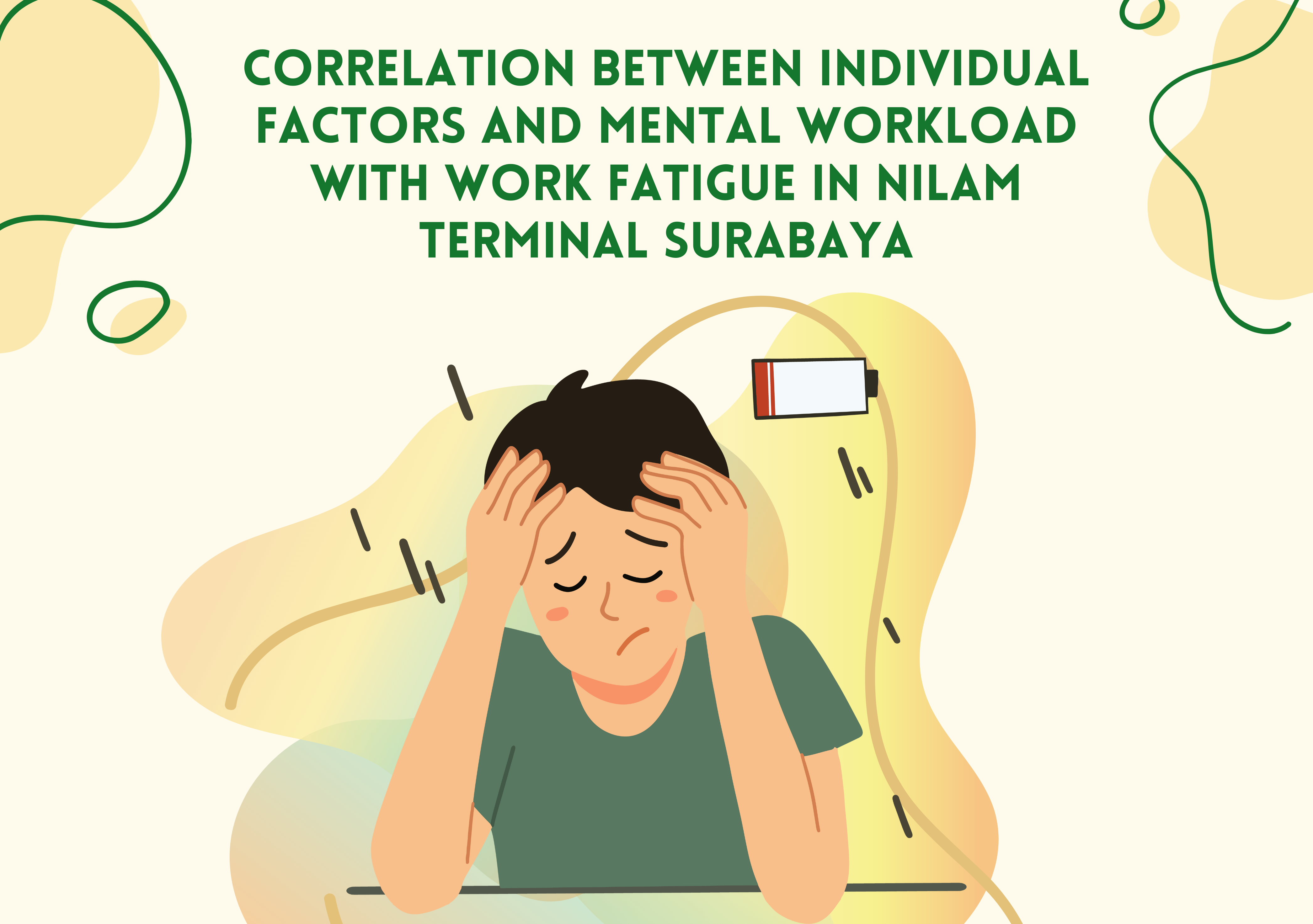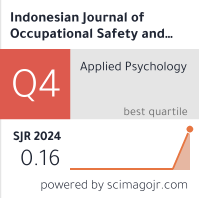Correlation between Individual Factors and Mental Workload with Work Fatigue in Nilam Terminal Surabaya

Downloads
Introduction: Work fatigue can be caused of excessive workload and work capacity such as age and tenure. This study aimed to analyze the strength of the correlation between individual factors and mental workload with work fatigue on the Surabaya Patchouli Terminal crane operator. Methods: The study design is a cross sectional. The sampling technique taken was total sampling so that all populations were a sample of 30 people, consisting of CC and RTG operators in Nilam Terminal Surabaya. The independent variables are individual factors including age and years of service obtained from the questionnaire, mental workload which is assessed based on the NASA-TLX questionnaire, while the dependent variable is work fatigue measured using a reaction timer. The collected data were then analyzed using the Spearman correlation. Results: The results show 23 operators (76.7%) experienced heavy work fatigue and 7 operators (23.3%) experienced moderate work fatigue. Conclusion: The strongest correlation is mental workload with work fatigue and the weakest correlation is age with work fatigue. Meanwhile, correlation tenure with work fatigue is in between. It is recommended to provide psychological consultation once a week for operators.
Alves, A. M. S. et al. (2020) ‘Factors Influencing Occupational Accidents: A Multidimensional Analysis in the Electricity Sector', Gestao e Producao, 27(2), pp. 1–17.
Amalia, N. R., Wahyuni, I. and Ekawati (2017) ‘Hubungan Postur Kerja Dengan Keluhan Kelelahan Kerja Pada Operator Container Crane PT. Terminal Peti Kemas Semarang', Jurnal Kesehatan Masyarakat (e-Journal), 5(5), pp. 290–298.
Amponsah-Tawiah, K. and Mensah, J. (2016) ‘Occupational Health and Safety and Organizational Commitment: Evidence from the Ghanaian Mining Industry', Safety and Health at Work, 7(3), pp. 225–230.
Anggorokasih, V., Widjasena, B. and Jayanti, S. (2019) ‘Hubungan Beban Kerja Fisik dan Kualitas Tidur dengan Kelelahan Kerja pada Pekerja Konstruksi di PT.X Kota Semarang', Jurnal Kesehatan Masyarakat (e-Journal), 53(9), pp. 1689–1699.
Ardiyanti, N., Wahyuni, I. and Jayanti, S. (2017) ‘Hubungan Beban Kerja Mental Dengan Kelelahan Kerja Pada Tenaga Keperawatan Dan Tenaga Kebidanan Di Puskesmas Mlati II Sleman Yogyakarta', Jurnal Kesehatan Masyarakat (e-Journal), 5(5), pp. 264–272.
Asriyani, N. and Karimuna, S. (2017) ‘Faktor Yang Berhubungan Dengan Terjadinya Kelelahan Kerja Pada Pekerja PT. Kalla Kakao Industri Tahun 2017', Jurnal Ilmiah Mahasiswa Kesehatan Masyarakat Unsyiah, 2(6), pp. 1–10.
Central Statistics Agency (2020) Jumlah dan Persentase Penduduk Bekerja dan Pengangguran 2019-2020. Jakarta: Central Statistics Agency.
Comin, L. C. and Pauli, J. (2018) ‘The Meaning of Work, Organizational Socialization and Work Context: the Perspective of Migrant Workers', RAM: Revista de Administraçí£o Mackenzie, 19(spe).
Dewi, I. G. A. A. D. A. and Wibawa, I. M. A. (2016) ‘Pengaruh Konflik Interpersonal Dan Beban Kerja Terhadap Stres Kerja Pada Kantor Sekretariat Daerah Kota Denpasar', E-Jurnal Manajemen Universitas Udayana, 5(8), pp. 4865–4891.
Haworth, N. and Hughes, S. (2012) Keselamatan dan Kesehatan Kerja Sarana untuk Produktivitas. Jakarta: International Labour Organization.
Hidayah, N., Musyarofah, S. and Widjasena, B. (2018) ‘Analisis Beban Kerja Terhadap Kelelahan Kerja Antara Shift Pagi Dan Shift Siang Pada Pekerja Di Bagian Operasional', Jurnal Ilmiah Permas: Jurnal Ilmiah STIKES Kendal, 8(2), pp. 107–115.
International Labour Organization (2013) ‘The Prevention Of Occupational Diseases', Encyclopedia of Toxicology: Third Edition, (April), pp. 1075–1076.
International Labour Organization (2018) Menuju budaya pencegahan keselamatan dan kesehatan kerja yang lebih kuat di Indonesia. Jakarta: International Labour Organization.
Jauhari, M. A. (2019) ‘Analysis on Factors Causing Fatigue among Steel Casting Workers at PT X Sidoarjo', The Indonesian Journal of Occupational Safety and Health, 8(2), pp. 224–232.
Kakerisa, A. L., Soleman, A. and Prasetyo, B. R. A. (2019) ‘Analisis Beban Mental Kerja Dan Fisik Karyawan Pada Lantai Produksi Dengan Metode NASA-TLX Dan Cardio Vascular Load (Studi Kasus: PT. Fajar Utama Intermedia Cabang Ambon)', ARIKA, 13(1), pp. 63–69.
Ministry of Public Health (2013) ‘Gambaran Kesehatan Lanjut Usia di Indonesia'. Jakarta: Ministry of Public Health.
Kusgiyanto, W., Suroto and Ekawati (2017) ‘Analisis Hubungan Beban Kerja Fisik, Masa Kerja, Usia, Dan Jenis Kelamin Terhadap Tingkat Kelelahan Kerja Pada Pekerja Bagian Pembuatan Kulit Lumpia Di Kelurahan Kranggan Kecamatan Semarang Tengah', Jurnal Kesehatan Masyarakat (e-Journal), 5(5), pp. 413–423.
Lua, W. M. P. (2015) ‘Analisis Beban Kerja Mental Pekerja Reagent Area Menggunakan Metode Nasa-Tlx Di PT Meares Soputan Mining'. Undergraduate Thesis. Bandung: Department of Industrial Engineering Institut Teknologi Harapan Bangsa.
Marfuah, R. (2021) ‘Hubungan Faktor Personal Dan Safety Climate Dengan Safety Behaviour (Studi Pada Operator Container Crane di PT X Surabaya)'. Undergraduate Thesis. Surabaya: Faculty of Public Health Universitas Airlangga.
Maslach, C. and Leiter, M. P. (2016) ‘Understanding the Burnout Experience: Recent Research and its Implications for Psychiatry', World Psychiatry, 15(2), pp. 103–111.
Pelindo III (2018) Arus Petikemas Pelindo III Naik 8,5 Persen. Surabaya.
Pramuditta, L. and Kunaefi, T. D. (2016) ‘Hubungan Karakteristik Pekerja Dengan Unsafe Action Pada Tenaga Kerja Bongkar Muat Di PT . Terminal Petikemas Surabaya', Jurnal Tehnik Lingkungan, 22(2), pp. 42–51.
Pratama, A. K. (2014) ‘Hubungan Karakteristik Pekerja Dengan Unsafe Action Pada Tenaga Kerja Bongkar Muat di PT . Terminal Petikemas Surabaya', The Indonesian Journal of Occupational Safety and Health, 4(1), pp. 64–73.
Prayogi, A. R. Y., et al. (2020a) ‘Determinan Tingkat Depresi Mahasiswa pada Masa Pandemi Covid-19 ( Studi Kasus Mahasiswa Universitas Airlangga Surabaya)', Journal Of Community Mental Health And Public Policy, 2(2), pp. 1–9.
Prayogi, A. R. Y., et al. (2020b) ‘The Determination of Safe Concentration of Non-Carcinogenic Toluene in Surabaya Printing', The Indonesian Journal Of Occupational Safety and Health, 9(3), pp. 360-368.
Rahmawati, N. D. and Tualeka, A. R. (2019) ‘Correlation between Individual Characteristics, Workload, and Noise with Work Fatigue', The Indonesian Journal of Occupational Safety and Health, 8(2), pp. 139-149.
Social Security of Employment (2019) Angka Kecelakaan Kerja Cenderung Meningkat, BPJS Ketenagakerjaan Bayar Santunan Rp1,2 Triliun, Social Security of Employment.
Soedirman and Suma'mur (2014) Kesehatan Kerja Dalam Perspektif Hiperkes dan Keselamatan Kerja. 1st edn. Edited by S. Carolina and R. Astikawati. Magelang: Penerbit Erlangga.
Suma'mur (2014) Higiene Perusahaan dan Kesehatan Kerja (Hiperkes). Jakarta: Sagung Seto.
Tarwaka (2019) Ergonomi Industri Dasar - Dasar Pengetahuan Ergonomi dan Aplikasi di Tempat Kerja. Surakarta: Harapan Press.
Triminingsih, K. A. (2018) Hubungan Antara Beban Kerja Mental dengan Kelelahan Kerja (Studi Pada Masinis UPT Crew KA Blitar DAOP VII Madiun PT. Kereta Api Indonesia (Persero)). Undergraduate Thesis. Surabaya: Faculty of Public Health Universitas Airlangga.
Wan, J. J. et al. (2017) ‘Muscle Fatigue: General Understanding and Treatment', Experimental and Molecular Medicine, 49(10), pp. e384-11.
Zain, A. M (2019) Analisis Beban Kerja Mental Menggunakan Metode NASA-TLX Studi Kasus CV Tigas Serangkai, Balikpapan, Kalimantan Timur. Yogyakarta: Faculty of Industrial Technology Universitas Islam Indonesia .
Copyright (c) 2023 The Indonesian Journal Of Occupational Safety and Health

This work is licensed under a Creative Commons Attribution-NonCommercial-ShareAlike 4.0 International License.

In order to be accepted and published by The Indonesian Journal of Occupational Safety and Health, Author(s) who submit an article should complete all the review process. The copyright of received articles assigned to the The Indonesian Journal of Occupational Safety and Health and Department of Safety and Health, Universitas Airlangga as publishers of the journal. The intended copyright includes the rights to publish articles in various forms (including reprints).
The Editorial Team of The Indonesian Journal Of Occupational Safety and Health and Department of Safety and Health strive to ensure that no errors occur in the articles that have been published, both data errors and statements in the article.
Users of this website will be licensed to use materials from this website following the Creative Commons Attribution-NonCommercial-ShareAlike 4.0 International License. No fees charged. Please use the materials accordingly.
------------------------------------------------------------------------------------------------------------------------------------------------------------------------------------------
Attribution ” You must give appropriate credit, provide a link to the license, and indicate if changes were made. You may do so in any reasonable manner, but not in any way that suggests the licensor endorses you or your use.
NonCommercial ” You may not use the material for commercial purposes.
ShareAlike ” If you remix, transform, or build upon the material, you must distribute your contributions under the same license as the original.







 How to Submit Articles in OJS
How to Submit Articles in OJS

























